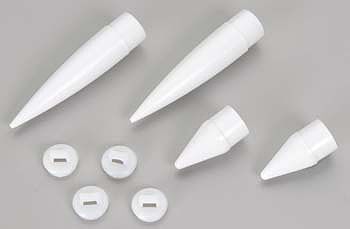Matt_The_RocketMan
Well-Known Member
So here are the legth dimensions for an aphla nose cone , 2.75 in make the adjustment.. tinker cad isnt helping how do i down size from the large to the smaller work plane to make the nose cone exactly?

Ok i got the scale part down ty , I was mentioning the actual nose cone to a model rocket , via the little arch that allows you to attach para and shock ... (this can be done but its proven to be to brittle)Matt, I'm not sure I / we follow what you're asking.
Are you asking about attaching the NC to the rocket in the real world? (this you should now, via a shock cord!)
Are you asking how to assemble the parts in CAD (In CAD, you need to make an assembly file, and constrain the parts to each other)
As for your 2nd question, you should be scaling the part. There should be a function to 'scale' the part, and its in percentage.. a 50% scale would reduce the model to half it's size. a 200% scale would increase it to 2 times it's size. Do you know how to work out what your scale factor (the percentage) should be?
Ok i got the scale part down ty , I was mentioning the actual nose cone to a model rocket , via the little arch that allows you to attach para and shock ... (this can be done but its proven to be to brittle)


yes exactly that but ... i still think that the way its going to print its going to have the most amount of stress, i think the viking version i showed you printed separate is going to be just fine, or if you want to make the print a bit more buff you could print the two pieces as a whole. ( I'm saying this due the fact that in Physics wise that plastic is must more out there and would cause stress points via cracking so yeah)OK, so what you are asking is that the attatchment is too weak, and you want o improve it; make it thicker / stronger / more resilient to shock loading. You want to make what you show in post #49 look like the parts in post #60.
Something like this?
View attachment 381598
Again, why not make a boss and use an eye screw? much easier to model a hole than an eye in the part. Easier to print, and will be stronger too..
actually im regarding Mid to low power rocket build not high powered part.. just and fyiOK, so what you are asking is that the attatchment is too weak, and you want o improve it; make it thicker / stronger / more resilient to shock loading. You want to make what you show in post #49 look like the parts in post #60.
Something like this?
View attachment 381598
Again, why not make a boss and use an eye screw? much easier to model a hole than an eye in the part. Easier to print, and will be stronger too..
again i like the concept idea but how do you attach it to the rocket without it breaking , this nosecone isnt the problem it the attachment part which you add a shock cord too. Actually i sorta have an idea on that one , you know the viking rocket nose cone?

That probably can be made exactly like this just larger , maybe a thicker cone size also
can you tell me how to get that?Well its been said and said again but if you start counting votes I figure I had to get mine in for Fusion 360. Can't speak highly enough about it, although in reality whatever you get fluent in and learn well (assuming a reasonably capable software) could do you well. I have Creo, Solidworks.....but I now like Fusion the best. Great value and as its also been stated - free for hobbyists.......
can you tell me how to get that?
Enter your email address to join: